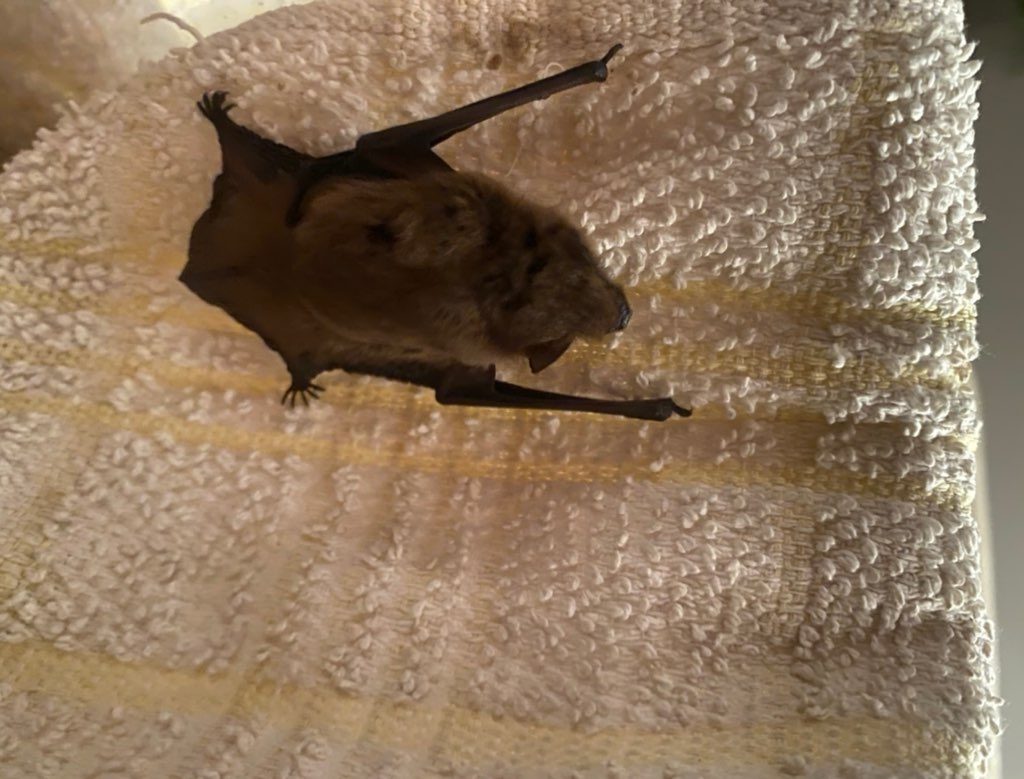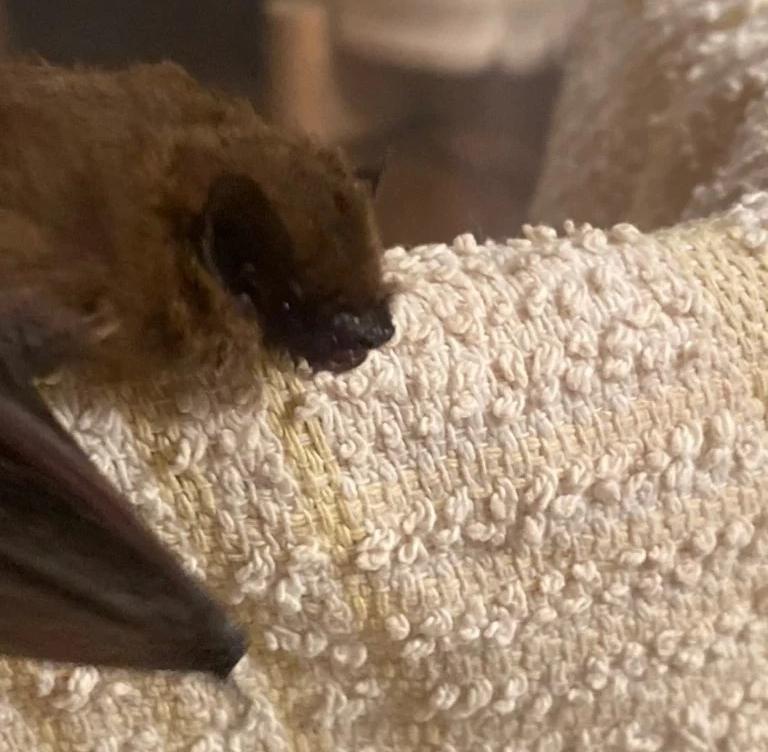Shortly before I left London, I went on a Bat Walk. Characteristically ill-equipped, I stepped off the no. 243 bus onto Stoke Newington High Street in a summer dress and sunglasses before slipping through the gates of Abney Park Cemetery as the sun was setting. But I scarcely noticed the sudden chill, I was so thrilled by glimpses of dark furry forms darting through the air accompanied by bursts of echolocation through a bat monitor.

The walk was led by my friend, the field ecologist, wildlife artist, and bat expert, Charlotte Brennan (also known as Pink Charlotte), who shared some of her vast knowledge with around 30 Bat Walkers that day. Did you know that there are over 1,400 different species of bats in the world and that they account for a quarter of mammal species in the UK and around 20 percent of all mammal species worldwide? We’ve given bats a really hard time over the centuries: wrongly blaming them for transmitting diseases, getting tangled up in our hair and consorting with the devil; poisoning them with pesticides, and destroying their homes and travel routes with more and more buildings, roads and intensively ploughed fields. Artificial lighting can also cause them trouble, as it can delay or prevent them from coming out to feed.

The bat species we were lucky to encounter on the Bat Walk were Common Pipistrelle, Soprano Pipistrelle, and Noctule. The ruined non-denominational chapel at the heart of the park made the perfect roosting site. Both types of pip took an erratic flight path, twisting and turning as they homed in on their flying insect prey, while the Noctules set a steadier course with sudden steep dives to snap up their supper. But of course, we needed bat detectors for identification. These convert bat calls into distinctive sounds within the frequency range humans can hear. Individual bat species emit calls at different frequencies, due to their size and flight style. So, a reading of around 45kHz indicated a Common Pip, while one of around 55 to 60 kHz signaled a Soprano. Pink Charlotte also had a nifty gadget, which connected with an app to instantly identify a particular species without any tuning required.

Not only had I forgotten to bring a cardigan that evening, I hadn’t applied any insect repellant either. But I emerged from the cemetery mercifully unbitten, thanks perhaps to the efforts of the bug-snaffling bats around me?
When we moved from London to Worcester the following month, I was gladdened to see bats in our new garden. Mr. Rixon and I spent many an evening entranced as they looped the loop above our heads and skimmed along the hedgeline. Pink Charlotte paid us a visit on my birthday in May last year, bringing bat detection devices and birthday cake, and we discovered that the same three species – Common and Soprano Pipistrelle and Noctule – were in residence in the garden. She found no evidence of recent roosts in our loft, which gave us the go-ahead to begin work on insulating and decorating it. However, we didn’t get very far with this as we decided not to buy the house after all and have recently moved out (but that’s a different story).

My most magical bat encounter came in December last year (2022) when I walked into the bathroom and saw a bat on Gwendolyn’s toothbrush. For a while, my brain struggled to process what my eyes were seeing; they kept trying to convince me that it was a used teabag that just happened to have feet. It could not have been there very long because my kids had only just brushed their teeth and were currently tucked up in bed listening to Mr. Rixon reading a bedtime story. Not knowing what to do for the best, I opened the bathroom window and shut the door, but instead of exiting via the window, the bat flew under the door and did several circuits of the kids’ bedroom before disappearing up to the loft to find a more suitable hibernation spot (or so we hoped).

The bat (a Common Pipistrelle) made a reappearance a few nights’ later, zooming around the kitchen, but showed no interest in open doors or windows. And then for about a week afterwards it would materialise beneath the ceiling in various rooms of the house. I hadn’t believed Pink Charlotte when she’d said that bats were predated by cats, but then I witnessed our 11-year-old cat Cookie whose main pursuits include sleeping, eating and lap-kneading, nearly catch our bat in a lightning leap. Finally, I noticed the bat come to rest within the folds of a Roman blind on the landing window.

I rang the Bat Conservation Trust‘s national bat helpline, and spoke to a volunteer who thought that the bat was probably a young one who perhaps hadn’t eaten enough to get it through hibernation and had become confused. On her advice, we captured the bat and placed it inside a shoebox with air holes, a teatowel in which to hide, and a bottlecap of water. Capturing the bat was no small matter and involved Mr. Rixon up a stepladder trying to prize the disgruntled bat off the blind with a gardening glove. My contribution was suggesting he remove the glove and place it inside the shoebox too when the bat refused to leave his hand.

After 24 hours of trying to track down a bat rescuer, Emma from Evesham Bat Care arrived. She told us that she would feed our bat up on mealy worms (the closest commercially available food to his natural diet), and, provided he was uninjured, release him in a suitable spot. And, that’s exactly what she did. Good luck little fella! I hope you found a new home that you like as much as we like ours!
I wonder whether we’ll see any bats from our new garden now that spring has finally arrived? They are such mysterious, other-worldly creatures; it is amazing that you can see them in your garden or local park or sometimes even, on your toothbrush.



Charlotte, a wonderful post and story about your bat experiences! I’m no expert but even here, so far north, on the edge of town they do appear (common pipistrelle), circling under the big oak tree in a neighbour’s garden, on warm summer evenings. Love them! I love your story but why the toothbrush? Intriguing! I’m now happier to know that you are settling into your new home, bats and all! 😊 A few years ago, I attended a bird id meeting when one of the participants said she had to leave the room for about 30 minutes. It turned out that she was a bat ‘nurse’ and she had slipped out to feed the bat she was caring for; it was a baby, hung around her neck in a pouch (body heat to keep it warm). Amazing! PS. It’s lovely to meet you & Mr Rixon, & Pink Charlotte, above. 🤗😊🙋♂️
LikeLike
Hello Charlotte! What an incredible story – I can well imagine that you couldn’t believe your eyes – a bat on a toothbrush! And one that refused all avenues of ‘escape’! So glad the story had a happy ending. It’s good to know that such wonderful volunteers and experts exist!
Before a well-known house builder moved in to develop the playing fields behind our house there were several bat colonies – in a disused cricket pavilion and a huge old oak tree. We used to see the bats flying around our garden at dusk. But no more. Despite experts being on hand with their advice, neither pavilion nor tree escaped the march of progress/housing. I wonder where the bats went to? Hopefully they found a new roost.°
LikeLike